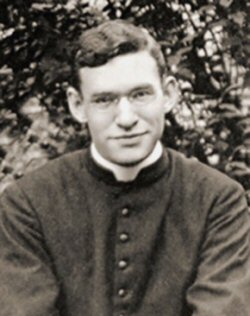 From the Archdiocese of Washington website
From the Archdiocese of Washington websiteBy Msgr. Charles Pope
On February 2 the National Conference of Catholic Bishops released a report on Religious life. The study was conducted by the very reputable Center for Applied Research in the Apostolate (CARA).
The Bishops’ report is interesting and informative for what it says, but also has puzzling omissions in the topics covered, which seem to amount to ignoring the “elephant in the room.” The “elephant” is the rather obvious fact that religious communities that preserve traditional elements such as the habit, common prayer, communal life, focused apostolates and strong affirmation of Church teaching, are doing well in comparison to orders that do not. Indeed some are doing quite well.
That data regarding the strength of tradition is covered in an earlier 2009 CARA report commissioned by the The National Religious Vocations Conference (NRVC). Strangely the bishop’s report did not seem to want to go near the topic of tradition. Hence I would like to look at some data from both the 2011 report and the 2009.
Let’s start with the 2011 Bishop’s Report. The Full report is HERE. The numbers are from CARA and refer to sisters who made their Solemn Vows in 2010. The comments are just my own.
1.Scope – 311 Superiors responded to the survey and this represents 63% of Religious Congregations in the USA
2.Most lay fallow – It is striking that the report indicates that 84% of Religious Communities had no one profess solemn vows in 2010. 13% had one woman profess solemn vows and only 3% had between 2 and 9 women profess solemn vows. While this is only a picture of one year it shows that a large number of communities are in very serious shape.
3.Missing Data? The report must have excluded some of the more fruitful congregations since I personally know of two communities that had more than 9 women enter.
4.Diversity – 62% of newly professed sisters are Caucasian, 19% are Asian or Pacific Islander, 10% are Hispanic. This suggests a lot of work needs to be done to reach the Hispanic (Latino) Catholic communities in the US which are very underrepresented in the numbers entering.
5.Older sisters less diverse – An astonishing 94% of sisters overall are Caucasian but this number is sure to drop a bit as the numbers in point four begin to shift forward in the years ahead.
6.Converts – 13% of newly professed sister in 2010 were converts.
7.Big Families Factor – A remarkable 64% came from families of 5 or more children. See pie chart at upper right. This confirms the long held notion that decreased family size is a significant factor in the decline of religious vocations.
8.School Connections – 51% of new professed sisters attended Catholic elementary school. For decades Catholic Schools had been an engine of vocations for sisters. That seems a wash today and is likely due to the fact that most schools have few if nay Sisters teaching.
9.Parish connections – 2/3 of the Sisters had participated in parish youth ministry programs and/or young adult ministry or Newman clubs.
10.Liturgical Connections – 57% had been involved in some sort of liturgical ministry.
11.Devotional Connection – 74% of the New Sisters had participated in Parish retreats, 65% prayed the rosary frequently, 64% participated regularly in Eucharistic Adoration. 57% had taken part in regular Bible Study programs. Hence parish life and traditional pious factors play and important role as does more more modern forms such as liturgical ministry and Bible Study.
12.Encouragements – 52% of new sisters report being encourged to enter religious life by another sister, 44% by a friend 39% by a parish priest.
13.Only 26% say their mother encouraged them on only 16% say their father encouraged them.
14.Discouragements! – An astonishing 51% say their parents or family members actively discouraged them from entering! This is quite an awful statistic actually. The very ones who should encourage are off message.
OK a lot of good information. But in the end the report seems to dodge the question as to why 84% of Religious Congregations had no one profess vows. I do not blame CARA for this since they likely received the scope of the survey from their patrons at the USCCB. The question remains though, why do some congregations show success and others not? What are the factors that most influence women to enter certain orders and not others?
Fortunately another CARA study mentioned above was commissioned by NRVC in 2009 and it does explore such questions. The full report is HERE and the findings are these:
1.Scope – The response rate in this survey was higher, about 80% of Religious in the US had their community respond to the survey. Most of the communities that did not respond were small larelgly contemplative communities.
2.The Survey includes both men and women.
3.How many in Formation – Three-fourths of institutes of men (78 percent) and two-thirds of institutes of women (66 percent) have at least one person currently in initial formation (candidate or postulant, novice, or temporary professed). However, almost half of the institutes that have someone in initial formation have no more than one or two. About 20% of the responding institutes currently have more than five people in initial formation.
4.Aging – Over all religious are an aging population. 75% of Men are over 60 and an astonishing 91% of women are over 60.
5.More diverse – Compared to men and women religious in the last century, those coming to religious life today are much more diverse in terms of their age, racial and ethnic background, and life experience. 21% are Hispanic/Latino, 14% are Asian/Pacific Islander, and 6% are African/African American. About 58% are Caucasian/white, compared to about 94% of older professed members. This show a significantly higher percentage of Latinos than the smaller 2010 survey above.
6.Critical Factors – Younger respondents are more likely than older respondents to say they were attracted to religious life by a desire to be more committed to the Church and to their particular institute by its fidelity to the Church. Many also report that their decision to enter their institute was influenced by its practice regarding a religious habit. Significant generational gaps, especially between the Millennial Generation (born in 1982 or later) and the Vatican II Generation (born between 1943 and 1960), are evident throughout the study on questions involving the Church and the habit. Differences between the two generations also extend to questions about community life as well as styles and types of prayer. Ah, so here is the elephant that the 2011 report chose to leave unexplored. The italics in this sixth point are a direct quote from the CARA report and it makes it clear that data confirms what we already know anecdotally. Tradition and the respect for it is an important factor for younger vocations, as is fidelity to the Church.
7.Generation Gap – Millennial Generation respondents are much more likely than other respondents – especially those from the Vatican II Generation – to say that daily Eucharist, Liturgy of the Hours, Eucharistic Adoration, and other devotional prayers are “very” important to them. Pay attention Religious orders.
8.Communal life – When asked about their decision to enter their particular religious institute, new members cite the community life in the institute as the most influential factor in their decision (followed closely by the prayer life or prayer styles in the community). Most new members indicate that they want to live, work, and pray with other members of their religious institute, with the last being especially important to them. Responses to an open-ended question about what most attracted them to their religious institute reinforce the importance new members place on this aspect of religious life. When asked about various living arrangements, most new members prefer to live in a large (eight or more) or medium-sized (four to seven) community and to live only with other members of their institute. Younger respondents express even stronger preferences for living with members of their institute in large community settings. Findings from the survey of religious institutes suggest that that new membership is negatively correlated with the number of members living alone. That is, the higher the number of members who live alone, the less likely an institute is to have new members. Imagine wanting to live in community when you enter religious life. Here too we see that tradition is confirmed and the loose knit apartment style, dispersed living of many dying congregations is simply being rejected by younger people seeking religious life and to live, work and pray in community
9.The Habit – The responses to the open-ended question about what attracted them to their religious institute reveal that having a religious habit was an important factor for a significant number of new members.
Thus, the data of this earlier CARA report confirms what most Catholics already know: those who have vocations to religious life have a strong preference for the practices of tradition. A strong and enthusiastic love of Christ and his Church, fidelity to his teachings expressed through the magisterium, the wearing of the religious habit, vigorous common life and common prayer, a focused apostolate, joyful and faithful members of the community, all these are essential in attracting new vocations. Of course.
Death wish? This has been clear for some time now and why some religious communities do see the obvious and adapt is mystifying to say the least. The clear message of the Holy Spirit who inspires vocations, the clear admonition of Rome which has strongly requested the return to the habit and other reforms, and the obvious preference of the young people who vote with their feet, is a clarion call. Communities that follow these simple truths are growing, some are growing rapidly. Communities that refuse to follow these simple truths would appear to have a death wish.
Picture – My own parish convent is occupied by an order that does follow these truths and they are bursting at the seams. They have just out-grown our convent which housed over 25 of them. They have now moved to another larger convent and left four sisters behind here. I have no doubt that our convent will fill again soon for the Servant Sisters of the Lord are a growing order who obey well the Holy Spirit and thus attract many many vocations. Their picture solemn vows is posted above. God is faithful, he is also clear as to what it takes for a religious community to thrive.
























No comments:
Post a Comment